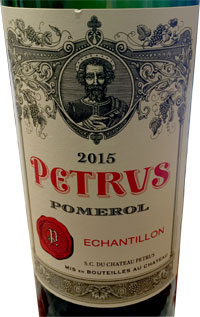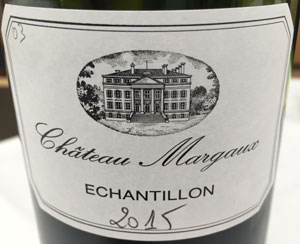The best Bordeaux en primeur
Matthew Jukes gives his verdict on the 2015 vintage of Bordeaux wines and reveals his favorite bottles.


I have just finished writing my 2015 Bordeaux En Primeur Report. This year I tasted well over 300 wines and typed 26,000 words into my iPad. On my return, I realised just how varied the wine trade's thoughts were on this vintage. We all agree that 2015 is a fascinating year with some sensational wines. The strange thing is that every person I quizzed had a different favourite. This is remarkable because normally one would hear of the same three or four producers ad infinitum.
It appears that for 2015 we are all singing a different tune, and this is rather lovely. It means that 2015 is a vintage where personal taste triumphs. But why is this the case and what happened during the all-important growing season to precipitate (an important word this year) these opinions? The answer is a year of extremes a lot of sunshine and a lot of rain. The winter was relatively mild and a cool March delayed bud-break until early April, when the temperature rose slowly.
There was a uniform and speedy flowering, which pointed to decent yields. Hot temperatures followed and this period was responsible for eliminating green characters in the grapes, much earlier in the season that normal. Temperatures rose again sharply in July so much so that it inhibited vine growth. Much-needed and highly beneficial rainfall arrived in early August and this helped to restart the ripening process. September was altogether more worrying, with frequent storms and much cooler weather. Those with the best terroir, with sufficient drainage, fared well, but others with water-retaining soils inevitably suffered.
MoneyWeek
Subscribe to MoneyWeek today and get your first six magazine issues absolutely FREE

Sign up to Money Morning
Don't miss the latest investment and personal finances news, market analysis, plus money-saving tips with our free twice-daily newsletter
Don't miss the latest investment and personal finances news, market analysis, plus money-saving tips with our free twice-daily newsletter

The Northern Mdoc was worst hit with the rains, but plenty of good wines have been made, while the Right Bank received similar weather patterns to the Left Bank, but much less rainfall, and this is why the wines are 1%-1.5% riper and richer on the whole. Left Bank dry whites seem tart and crisp and ideal for ageing, while sweet wines are undoubtedly fantastic and I would go as far as to say that 2015 can unequivocally be called a great vintage because of the pristine botrytis and scintillating acidity which many wines show.
To sum up, this is not as opulent or as long-lived a vintage as 2005, 2009 or 2010, but it is superior to 2014 and I am very taken with the wines because the best are stunningly pure, magnificently focused and exceptionally refined, particularly on the Left Bank where the alcohols hover around 13%. There is no doubt that the Right Bank fared very well, with slightly more favourable climatic conditions and the resulting wines are lush and showy, underpinned, once again, by thrilling acidity.

As always, I know which are the best wines, so you are in good hands, and you will determine whether or not to spend your money. There are many who excelled in this vintage, resulting in no less than 49 wines gaining a score of 18.5/20 or above in my Report this is the equivalent of 49 gold medal standard wines! This hit rate is unique in the world for cabernet and merlot, so please ignore the scaremongers and instead rely on your own common sense and good taste.
| 1. Chteau Haut-Brion (1er Cru, Pessac-Lognan) 20* | 1. Chteau Beychevelle (4me Cru, Saint-Julien) 18 |
| 2. Chteau Margaux (1er Cru, Margaux) 19.5 | 2. Clos Cantenac (Grand Cru, Saint-Emilion) 18 |
| 3. Chteau Loville-Las Cases (2me Cru, Saint-Julien) 19.5 | 3. Chteau Belgrave (5me Cru, Haut-Mdoc) 17.5 |
| 4. Vieux Chteau Certan (Pomerol) 19.5 | 4. Chteau Angludet (Margaux) 17.5 |
| 5. Ptrus (Pomerol) 19.5 | 5. Chteau La Vieille Cure (Fronsac) 17.5 |
| 6. Chteau La Conseillante (Pomerol) 19 | 6. Fugue de Nnin (second wine of Nnin, Pomerol) 17.5 |
| 7. Le Dme (Grand Cru, Saint-Emilion) 19 | 7. Chteau La Serre (Grand Cru Class, Saint-Emilion) 17 |
| 8. Chteau Trotanoy (Pomerol) 19 | 8. Chteau Teyssier (Grand Cru, Saint-Emilion) 17 |
| 9. Tertre Roteboeuf (Grand Cru, Saint-Emilion) 19 | 9. Chteau Ormes de Pez (Saint-Estphe) 17 |
| 10. Chteau Grand-Puy-Lacoste (5me Cru, Pauillac) 19 | 10. Rserve de Comtesse de Lalande (second wine of Pichon Lalande, Pauillac) 17 |
| * My score out of 20 | Row 10 - Cell 1 |
Get the latest financial news, insights and expert analysis from our award-winning MoneyWeek team, to help you understand what really matters when it comes to your finances.
Matthew Jukes has worked in the UK wine business for well over three decades and during this time has written 14 wine books.
Matthew regularly lectures, judges, speaks at wine conferences and runs masterclass tastings for both corporate and private clients all over the world. Matthew is also the creator of his ground-breaking initiative, the One Day Wine School, an indulgent day of tasting and learning first performed in 2006.
He has been the MoneyWeek wine correspondent since 2006 and has written a weekly column for the Daily Mail’s Weekend Magazine since 1999. His four highly-acclaimed, annual wine reports – the Burgundy En Primeur Report, the Bordeaux En Primeur Report, the Piemonte Report and the 100 Best Australian Wines – are published on his website, www.matthewjukes.com.
Matthew is one of the world’s leading experts on Australian wine and, with Brisbane-based wine writer Tyson Stelzer, runs an annual competition in Australia to find ‘The Great Australian Red’. He was made Honorary Australian of the Year in the UK at the 2012 Australia Day Foundation Gala dinner.
Matthew is a winner of the International Wine and Spirit Competition's Communicator of the Year Trophy. His thoughts, recommendations and tastings notes are followed very closely by the wine world at large.
-
 ‘Why I have ditched my Help to Buy ISA for cash savings and the stock market’
‘Why I have ditched my Help to Buy ISA for cash savings and the stock market’Without the 25% bonus, my Help to Buy ISA is effectively redundant, says MoneyWeek writer Sam Walker.
-
 Is your inheritance tax allowance cut if you sell to downsize or sell your home to pay for care?
Is your inheritance tax allowance cut if you sell to downsize or sell your home to pay for care?Downsizing relief is a little-known benefit that could save your loved ones tens of thousands of pounds in inheritance tax after you’ve died.
